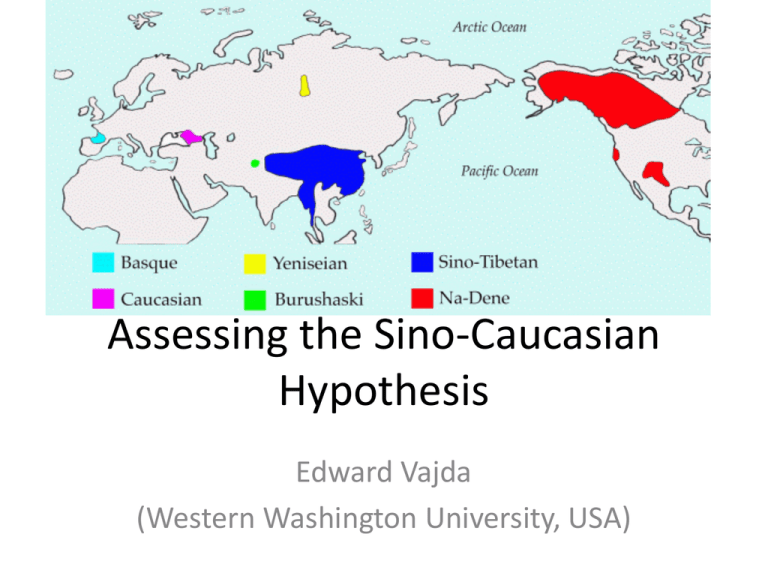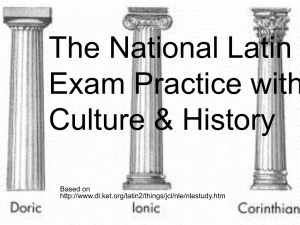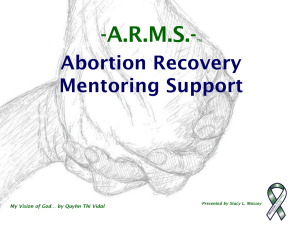Assessing the Sino-Caucasian Hypothesis
advertisement

Assessing the Sino-Caucasian Hypothesis Edward Vajda (Western Washington University, USA) Sergei A. Starostin 1. Extensive knowledge of many diverse languages and families 2. Painstakingly accurate compilations of lexical data 3. Bold consideration of linguistic classification at increasingly deep time depths 4. Rigorous reconstructions of individual families (Starling), a number of them representing seminal contributions to their respective fields One of S. A. Starostin’s most innovative proposals: The Sino-Caucasian Hypothesis (1982) S.A. Starostin’s reconstruction of the phonological system of Old Chinese (1989) is widely known. Further progress in reconstructing the deeper Proto-SinoTibetan will be crucial to demonstrating the family’s external genealogical relations. S. A. Starostin’s (1995) reconstructed Proto-Yeniseian forms are a cornerstone of Yeniseian historical linguistics. Current location of Ket speakers Yeniseian-speaking groups attested in 17th century Tsarist fur tax records (Key importance of preliminary documentation work by M.A.Castrén, A.P. Dul’zon, G.K.Verner and others) S. L. Nikolaev and S. A. Starostin A North Caucasian Etymological Dictionary (1994) proposed extensive lexical evidence for Abkhaz-Adyghe + Nakh-Daghestanian (Kartvelian is not connected with the two North Caucasian families) The broader “Dene-Caucasian” Hypothesis (investigated by John Bengtson, Vaclav Blažek, and others during the past two decades) Lexical comparisons and comparisons between various Dene-Caucasian pronominal systems are promising. However, there is currently no consensus among proponents of this family as to its proper internal subgrouping. George Starostin (2009) Closer connection between Burushaski and Yeniseian within some sort of broader “Sino-Caucasian” or “Dene-Caucasian” family. (George Van Driem’s earlier “Karasukh Hypothesis” was not set in a larger family) Investigations of a language link between Yeniseian and Na-Dene. Alfredo Trombetti (1923) Ket-Kott + Athabaskan-Tlingit Merritt Ruhlen (1998) closer connection between Yeniseian and Na-Dene (including Haida) within an expanded Sino-Caucasian family E.J.Vajda (2008, 2010, 2012) Yeniseian + Na-Dene (minus Haida), probably within a larger grouping including other Old World families ‘conifer tree, branch, needles’ Proto-Yeniseian: *qoˀn Proto-Athabaskan-Eyak: *Gand ‘liver’ Proto-Yeniseian: *sēˑŋ Proto-Athabaskan-Eyak: *seŋt’ TONOGENESIS in Yeniseian from glottalized vs. non-glottalized codas Na-Dene plain coda corresponds to Yeniseian abrupt tone in the preceding vowel: ‘conifer’ Na-Dene: *Gand Ket: qoˀn Na-Dene glottalized coda corresponds to Yeniseian high tone in the preceding vowel: ‘liver’ Na-Dene: *seŋt’ Ket: sēˑŋ Nasal + Obstruent final cluster simplification Na-Dene Yeniseian *CvnC CvhC ~ CṽC ‘conifer’ Na-Dene: *Gand ‘dark’ Na-Dene: *q’uns ‘liver’ Na-Dene: *seŋt’ ‘wart’ Na-Dene: *xeˑn’tš’ Cvn ~ CvnC Ket: qoˀn ~ qondKet: qoˀn ~ qonsKet: sēˑŋ ~ seŋ-in Ket: hɨ̄ˑn ~ hɨt-n Na-Dene: sporadic retention of nasal regular retention of obstruent Yeniseian: regular retention of nasal sporadic retention of obstruent Cognates beyond “Dene-Yeniseian” ‘liver’ Proto-Yeniseian: *sēˑŋ Proto-Athabaskan-Eyak: *seŋt’ Proto-Sino-Tibetan: *sin *kʷan ~ *gʷen A striking Dene-Caucasian etymon for “light” Subgrouping requires the discovery of shared innovations. Differences in the number of proposed cognates alone cannot easily demonstrate degrees of language relatedness. 1. The need to further refine family-internal reconstruction and historical development. 2. The importance of reconstructing morphology. (cf. George Starostin 1995 “Morphology of the Kott Verb”) Edward Vajda (2008, 2010) “A Siberian link to Na-Dene languages” compares Yeniseian and Na-Dene verb morphology. George Starostin (2012) review of above work, with important criticisms. Complex templatic morphology highly conservative and promising object of study for historical-comparative linguistics YENISEIAN NAKHDAGHESTANIAN ALGIC MUNDA BANTU Johanna Nichols and Ed Vajda (Linguistics Society of America Annual Meeting, January 2012 Na-Dene = Athabaskan-Eyak-Tlingit Proto-Na-Dene (6000 years ago ?) Proto-Athabaskan-Eyak Tlingit Athabaskan Eyak (no substantive evidence to include Haida, which appears to be an isolate outside the family) Linearly complex verb morphologies are generally not viewed as a promising object of historical-comparative analysis Found widely in the Americas, Australia, New Guinea, Caucasus, as well as in Bantu, Yeniseian, Munda, Tibeto-Burman, etc. Proto-Yeniseian (time depth over 2,000 years) Ket-Yugh and Kott-Assan are primary branches (Yastin, Yarin, Baikot are Kott dialects) The position of Arin and Pumpokol is debated. ProtoYeniseian Pumpokol and Arin are difficult to classify due to the paucity of attested vocabulary. ? ? ? ? Common Yeniseian (broke up at least 2000 years bp) Arin verbs Arin: SUBJ-x-a-tum (subject in object position) ba-x-a-tum ‘I go’ Ket-Yugh: *SUBJ-g-a-denʲ (subject in object position) Ket: bo-g-a-den ‘I go’ bo-g-on-den ‘I went’ Yugh: bo-g-a-denʲ ‘I go’ bo-g-ol-denʲ ‘I went’ Kott: *d’-a-SUBJ-gin-SUBJ.SUFF i-gin-aŋ ‘I go’ al-i-gin-aŋ ‘I went’ Arin patterns like Ket-Yugh with the subject marker before the thematic consonant, and also Yeniseian reclassified into three primary branches based on verb morphology Keto-Arin Yeniseian languages attested In 1600 Proto Yeniseian (at least 2000 years bp) 2. External genealogical relations between families are but one of many interesting facts about the history of the peoples who speak them. The value of a multidisciplinary approach to studying human prehistory, with language relatedness being only one component. The frequent link between genetic (DNA) relatedness of human populations and the genealogical relatedness of the languages they speak. Parallels between human genetic distance and language geneology. (idea pioneered by Ruhlen and Greenberg but based on autosomal DNA rather than nonrecombinant) Mitochondrial DNA (Mt-DNA) Passed on only by the mother, but carried by sons and daughters. Y-Chromosome DNA (Y-DNA) Passed on only from father to son. Assessing prehistory by triangulating evidence from different disciplines • Archaeology (and paleoclimatology) • Mitochondrial DNA (passed on to daughters and sons through the mother) • Y-chromosome DNA (passed from father to son) • Traditional material culture • Indigenous spiritual and intellectual heritage (including folklore motifs) • Language relationship (Important caveat: only language comparison itself can show language relatedness) Q1 Subclade (by 15,000 BP Q1a – Ket Q1a3a – Native Americans (arose by 12,000 BP) Non-Siberian clades of Q are more distantly related Y-DNA haplotype Q1a The predominant male haplogroup in nearly all Native Americans as well as Kets (over 90%) and Selkups (65%). Subclades of Q outside Siberia are more distantly related. Ket man (Hans Findeisen photo, 1927) Ket manHypothesis: ancient hunters carrying Haplotype Q1a spoke a language ancestral to Ket. In historic times, Kets were patriarchial and exogamous. Wives taken from other groups became part of the father’s clan and spoke Ket, as did their children. Hypothesis: The original predominant Ket Mt-DNA haplogroup was A , Other Ket Mt-DNA haplogroups U, F (now the majority) derive from ancient Baikal fisher-folk. Ket mother (V.Anuchin photo, 1906) Mt-haplogroups H, C in the Ket are more recent admixtures from Selkup and other contemporary neighbors. microblades Q+A Microblade-creating big game hunters expansion during the last phase of the Pleistocene Microblade Hunter Q+A Dispersal Hypothesis Q1 haplogroup became dominant among the already established Pacific Rim populations of Mthaplogroups B,C,D. The Q males eventually displace the earlier North Pacific Y-haplogroups. They also bring a new Mt-haplogroup: A. microblade hunting culture Q+A U X F C Hypothetical human DNA distribution in Northern Asia prior to the colonization of the Americas (before 15,000 years ago) Red = Y-DNA haplogroups, Blue = Mt-DNA haplogroups. extinct Yeniseian languages Microblade tradition Y-DNA haplogroup Q Mt-DNA haplogroup A Language ancestral to Ket and Na-Dene Na-Dene ancestors (after 12,000 BP) Stayed in northeastern Asia into the Early Holocene, long enough to acquire new Y-DNA haplogroup C3b moving up from East Asia. A late Pleistocene spread of the Microblade (Dyuktai) Culture and its possible link with Y-DNA haplotype Q1 and Mt-DNA haplotype A could also be associated with Sino-Tibetan, but not with the other putative members of Dene-Caucasian. The Chinese gene pool also contains the combination Q + A And North China contains microblade artifacts. Speakers of the south and west Eurasian Dene-Caucasian families do not share any special DNA connection with the three eastern families. An unrelated human genetic connection Burushaski speakers share a statistically significant incidence of a specific Y-DNA haplotype, L-M357 with speakers of NakhDaghestanian. Map showing general Y-DNA haplotype L The issue of time depth. Any connection between “Dene-Caucasian” families is likely to be older than 10,000 years. Summary 1. Many aspects of the lexical and pronoun comparisons already proposed between various families included in Dene Caucasian look promising. More work should be done on this. 1. Without clear and non-controversial evidence of “shared innovations”, it is premature to conclude that any of these families are more closely related to one another, including “Dene-Yeniseian”. 3. Greater effort needs to be made in morphological reconstruction in each individual family. 4. Morphological evidence for “Dene-Caucasion” or its subbranches should be sought, given the value of such evidence for distinguishing shared innovations from shared retentions. • 5. Arguing genealogical relatedness between languages should not be the main focus of historical linguistics. • 6. Demonstrating genealogical relatedness is a long and collaborative process. Critics and informed skeptics are collaborators. • 7. Although non-linguistic data cannot demonstrate language relatedness, it is valuable to consider what is known about other disciplines in the study of human prehistory, to hypothesize about the logically possible time depth and location of connections between now distant peoples and languages. Acknowledgments George Starostin (RGGU) – for his invitation to the conference and his persistent collaboration with me over the past few years. Matthew Anderson (Western Washington University office of Communications) – for filming this presentation as an overload to his schedule today.


